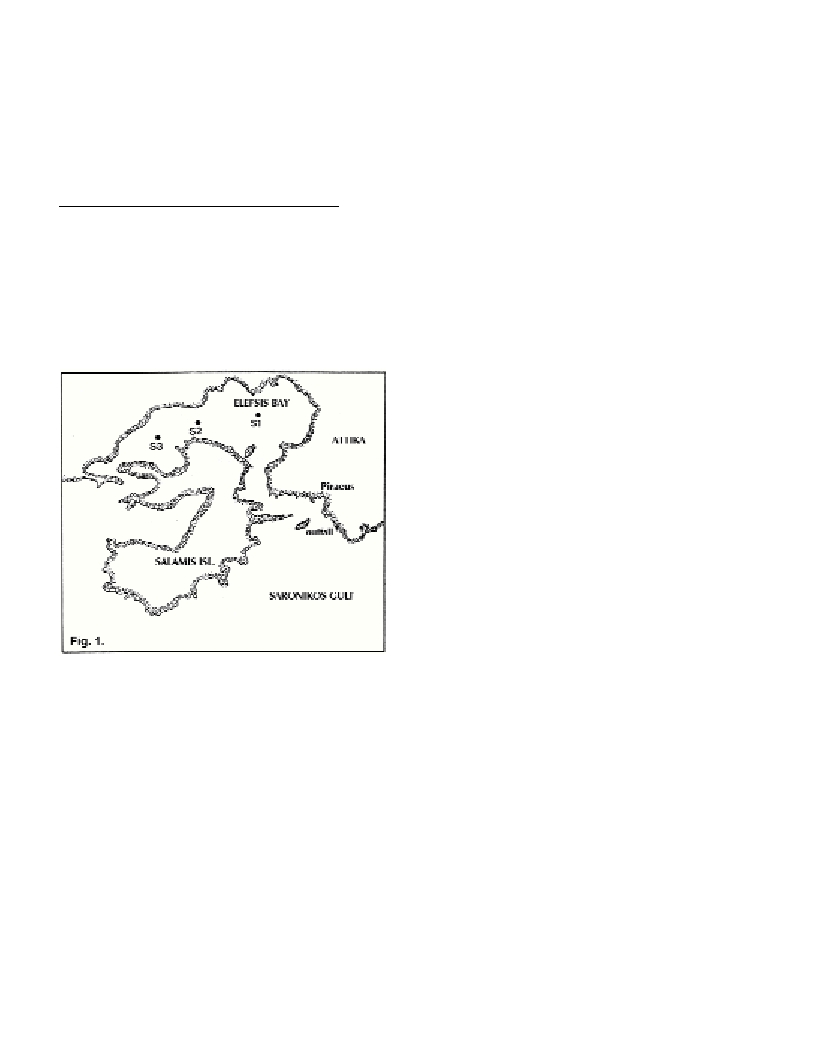LONG TERM CHANGES OF NUTRIENTS ENRICHMENT IN A GREEK ANOXIC MARINE BAY
N. Friligos*, R. Psyllidou-Giouranovits, A. Pavlidou
Hellenic Centre for Marine Research, PO Box 712, GR 190 13, Anavyssos, Attica, Greece - rpsill@ncmr.gr
Abstract
This paper concerns the nutrient status and the oxygen conditions between two different periods, 1973-1976 and 1993-1996, in the Elefsis
Bay, which is an anoxic basin in the Saronic Gulf. The development of a thermohaline circulation has significant implication for nutrient
cycles and oxygen distribution in the bay. The relation between the long-term accumulation of nutrients and denintification for the periods
1973-1976, 1993-1996, are discussed.
Keywords: Nutrients, eutrophication, Greek anoxic bay.
Rapp. Comm. int. Mer Mιdit., 37,2004
197
Introduction
The Gulf of Elefsis (Fig. 1) is an almost enclosed body of water
which is situated in the northern Saronikos Gulf. It is a small (67
km
2
), shallow area (max. depth 33 m) joined to the rest of the
Saronikos Gulf by two sills, 8 m minimum depth at the western end
and 12 m minimum depth at the eastern end. It differs from the rest of
the Saronikos Gulf not only in its morphology, but also in the extent
to which it is polluted. Most of this pollution arises form the industrial
complexes on its shores. It is also polluted by sewage from the main
outfall through the east channel. The present study deals with long
term nutrients enrichment over a long period of time (1973-1996).
Materials and methods
The topographical setting and typical station locations are shown in
Fig. 1. The sampling was performed seasonally during 1993-1996.
Measurements of temperature, salinity dissolved oxygen and
inorganic nutrients were performed by methods quoted by Friligos(1).
Results and discussion
Analysis of the data revealed that there was one general cycling of
temperature over the year. Cooling of the upper layers reached a
minimum in February-April, with temperatures of about 12-14
o
C.
Then water mass began warming up to maximum values of about 25
o
C in August. The salinity range was 38-39 psu. The density lay
within the range 26-29
s
t
and the pycnocline was related to the
thermocline. During the winter the water in the Gulf was well mixed
while, from May onwards, the gradual development of a thermocline
led to the stratification of the water column and, in late September,
there was a breakdown of the thermocline and vertical mixing of the
water column.
In summer, temperature differences of 10
o
C between sea surface
and bottom resulted in the development of a strong stratification,
which persisted for about 4 months and caused anoxic conditions
below 20 m. High salinities develop in the summer as a result of
evaporation and low temperatures occur during the winter as a result
of the shallow maxium depth, 33 m.
The period of stratification was accompanied by deoxygenation of
the water column below 20 m. The values of oxygen ranged between
1 and 7 ml/l in the water column at 0-20 m and 0.5 and 5 ml/l below
20 m. Anoxic conditions occurred below 20 m during the summer.
The values of silicate ?uctuated from 1 to 10
΅
M down to 20 m.
Below 20 m, the values were 1-45
΅
M. Silicate maxima occurred at
the bottom of the water column at times of stratification and
deoxygenation. The values of phosphate, down to a depth of 20 m,
ranged from 0.1 to 0.5
΅
M. Below 20 m, the values were 0.30 3.00
΅
M. The highest values up to 3
΅
M occurred during anoxic
conditions.
Increased values of nitrate of 0.5 2.5
΅
M were observed in the
winter. Owing to the denitrification during the period July October,
the nitrate value fell below 0.5
΅
M. The values of nitrite were between
0.1 0.5
΅
M above 20 m and 0.5 1.0
΅
M below 20 m. The corres-
ponding values of ammonia were 1 5
΅
M and 5 10
΅
M. It should
be noticed that in summer with the occurrence of denitrification,
nitrite exceeded nitrate. Higher ammonia values, as in the case of
silicate and phosphate, occurred during anoxic conditions. The
formation of ammonia and its subsequent oxidation to nitrate via
nitrite proceeds throughout the winter. Also we found during this
study (1993-1996), the tendency of the water of the Elefsis Bay to
accumulate nutrients above the background level. The Elefsis Bay
contained about three times more inorganic nitrogen than the
background; this was mainly due to the ammonia, which was about
five times more than the background value. Nitrate and nitrite also
were two times, more than the background. Moreover, phosphate and
silicate were respectively about five and four times more than the
background.
Friligos(1) reported that the Elefsis Bay during the period 1973-
1976 contained nine times more inorganic nitrogen than the
background; this was mainly due to the ammonia which was about
fifteen times more than the background value. Nitrates and nitrites
also were respectively, seven and three times more than the
background. However, the enrichment of phosphates and silicates
were similar to the period 1993-1996.
Thus the denitrification was greater for the period 1993-1996 and
the Elefsis bay worked as reductant biological treatment plant for the
case of nitrogen.
References
1-Friligos N., 1989. Nutrient and oxygen conditions in the Elefsis Bay,
and intermittently anoxic Mediterranean basin. Toxicol. and Environm.
Chemistry, 19:179-186.

